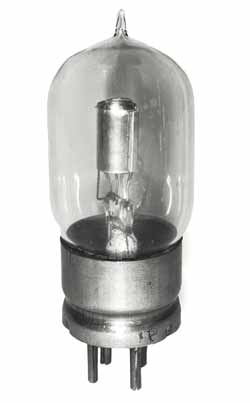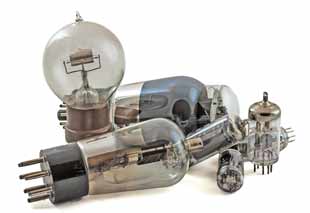History of Vacuum Tube / Thermionic Valve
The history of the vacuum tube or thermionic valve from the first observations of the Edison Effect through early developments such as Fleming's Oscillation Valve and de Forest's Audion.
History of the Valve / Tube Includes:
History overview
Early discoveries
Fleming's oscillation valve
de Forest's Audion
Development of the basic idea
R-type valve
6L6 valve
EF50 valve
The vacuum tube or thermionic valve brought the dawn of the age of electronics. Its invention enabled the wireless technology of the day to move forward.
The history of the vacuum tube or thermionic valve brings many individual discoveries together that enable the invention to be made.
The history of the thermionic valve also moves on to tell of the further developments that were made.
All these individual elements take their place in the overall history of the thermionic valve or vacuum tube.

Early Valve - possibly from around 1910
Valve history summary
During its history the vacuum tube or thermionic valve has played a pivotal role in many historical events and its invention has changed the way of everyday life.
Although the valve was first invented in 1904, and it was not widely used until the 1910s, the valve has been pivotal in laying the foundations of what we call electronics technology today. Radio technology, telecommunications, and many other areas all embraced the new thermionic technology, laying the basic foundations of many areas of technology that are taken for granted today.
As the need to valves / tubes grew, so did the requirements for their performance. To meet these needs operation at higher frequencies was needed along with higher levels of stability, gain and predictability.
A greater understanding of the physics behind the way in which these thermionic valves / vacuum tubes worked enabled much greater levels of performance to be achieved. As a result of this understanding, the performance of the valves improved and this enabled them to provide far higher levels of performance which in turn lead to their more widespread use.
Initially valves were expensive and only used in very small quantities. As an indication of this growth figures from the RCA company show that they sold about 1.25 million receiving valves or tubes in 1922 but by 1924 this has risen to 11.35 million.
Some of the key issues with valves that prevented their adoption were not only the cost of buying them, but the cost of running them. Early valves used directly heated cathodes and as a result required batteries to runt hem. Once indirectly heated valves were developed, this opened up their use considerably and they were more widely used in radios. In addition to this the superheterodyne radio required more valves to be used than the equivalent tuned radio frequency receivers started to be used around the late 1920s and early 1930s because of their superior performance. As these receivers were sued for domestic radios, the requirement for valves rose even more.
The outbreak of World War 2 was a key point in thermionic valve history. These devices came into their own as they were needed for electronic equipment of all sorts from radio receivers to transmitters, radar sets, electronic warfare equipment, telecommunications repeaters and much more.
During this period, valves were produced in vast quantities on both sides.
After the war, new requirements were placed on valves and the valve history or vacuum tube history shows that there was a major move towards miniaturisation. Early valves and their equipment were large. Now smaller equipment was needed and as a result smaller valves were produced.
However with the invention of the transistor in 1949, and its ultimate commercial use, the transistor was smaller, more reliable and consumed less power. Although initially they were not cheaper than valves, the prices soon fell leaving valves only used in some areas where their performance was superior. However as transistor and FET performance improved, there were very few areas were thermionic valve technology was superior to that of transistors. Accordingly the valve history shows that their use fell away sharply in the 1960s and by the 1970s very few valves were used.
Valve technology
Thermionic valve or vacuum tube technology developed to enable considerable degrees of functionality to be introduced into radio receivers and then the wider field of electronics.
Note on Vacuum Tube Technology:
Vacuum tubes or thermionic valves are based around the concept of thermionic emission. Using two electrodes enables diodes to be made that can rectify signals - further electrodes can be added to enable amplifiers to be made and other applications fulfilled.
Read more about Vacuum Tube Technology
Valve history timeline
There are some key dates in the development of the thermionic valve or vacuum tube. These dates are tabulated in a valve history timeline below:
| Valve history timeline | |
|---|---|
| Date | Event |
| 1640 | Otto von Guericke first produces an air pump that is able to create a partial vacuum. A vacuum was required for the operation of thermionic valves. |
| 1858 | Julius Plucker demonstrates that magnetic fields can bend rays of what are later called cathode rays |
| 1860 | Joseph Swann patents the carbon filament lamp |
| 1871 | Sir William Crookes deduces that cathode rays consist of negatively charged particles. |
| 1879 | Thomas Edison files a US patent for a high vacuum incandescent lamp using a carbon filament |
| 1883 | Thomas Edison observes thermionic emission in a vacuum. |
| 1883 | Professor John Ambrose Fleming of University College London, presents a paper to the Physical Society on the 'Molecular Shadow.' |
| 1885 | Sir William Preece replicates the Edison effect and makes measurements, presenting a paper to the Royal Society. |
| 1897 | Guglielmo Marconi sets up his Wireless telegraph and Signal Company to exploit radio or 'wireless' technology. |
| 1900 | Ambrose Fleming becomes a consultant to Marconi. |
| 1901 | Marconi makes the first transatlantic radio transmission, but difficulties were encountered with detecting he signals |
| 1904 | Ambrose Fleming rectifies wireless signals using what he terms his oscillation valve - this is the first time the Edison effect has been used. It was a simple diode valve and sometimes referred to as a Fleming Diode. |
| 1904 | On 16 November 1904 Ambrose Fleming applies for a patent for his oscillation valve. |
| 1906 | Having undertaken many experiments, Lee de Forest in the USA adds a third electrode to Fleming's diode to produce what he termed his Audion. This device was still only used for rectification. |
| 1908 | Ambrose Fleming replaces the carbon filament normally used in the diode valve with a tungsten filament. |
| 1912 | Lee de Forest makes the first valve amplifier. |
| 1915 | In France the first hard vacuum triode was made. It was called the Type TM and during the second World War over 100,000 of them were manufactured. |
| 1916 | British equivalent of Type TM valve started manufacture - it was known as the R-Type valve. |
| 1920 | Capt. S R Mullard forms the Mullard Radio Valve Co. Ltd. This was to become a major manufacturer of valves and then transistors. |
| 1920 | Thoriated tungsten filament for valves / vacuum tubes developed by Irving Langmuir |
| 1927 | The first valve with a screen grid starts manufacture - the S625. |
| 1936 | The International Octal, or just octal base was introduced by RCA. |
| 1938 | Mazda introduce Mazda Octal valve base as competition to the International Octal base |
| 1939 | The Loctal base (B8B) valve base or tube socket was introduced in USA |
| 1939 | Philips introduce an all glass valve / tube with the B9G base. |
| 1939 | The B7G valve base introduced in the USA for use with all-glass vacuum tubes. |

The valve history of tube history shows many improvements and developments are made to the basic concept. Over the years the performance the this technology improved beyond all recognition. Many different people each played their part in the history of the valve.
 Written by Ian Poole .
Written by Ian Poole .
Experienced electronics engineer and author.
More History:
Radio history timeline
History of the radio
Ham radio history
Coherer
Crystal radio
Magnetic detector
Spark transmitter
Morse telegraph
Valve / tube history
PN junction diode invention
Transistor
Integrated circuit
Quartz crystals
Classic radios
Mobile telecoms history
Vintage mobile phones
Return to History menu . . .




